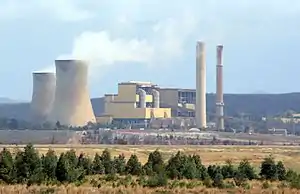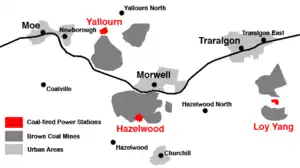Yallourn Power Station
The Yallourn Power Station is a complex of six brown coal–fuelled thermal power stations built progressively from the 1920s to the 1960s. Located in the Latrobe Valley of Victoria, Australia, the complex was situated beside the Latrobe River, with the company town of Yallourn located to the south west. Today only the 1,450 megawatts (1,940,000 hp) Yallourn W plant remains, the second largest power station in Victoria which supplies 22% of the state's electricity and 8% of the National Electricity Market needs. The adjacent open cut brown coal mine is the largest open cut coal mine in Australia, with reserves sufficient to meet the projected needs of the power station to 2032.
| Yallourn Power Station | |
|---|---|
 Yallourn W Power Station viewed from the south | |

Location of the Yallourn Power Station | |
| Country | Australia |
| Location | Yallourn, Victoria |
| Coordinates | 38°10′42″S 146°20′21″E |
| Status | Operational |
| Construction began | 1921 |
| Commission date |
|
| Decommission date |
|
| Owner(s) | EnergyAustralia (Yallourn W) |
| Thermal power station | |
| Primary fuel | Brown coal |
| Power generation | |
| Units operational |
|
| Nameplate capacity | 1,480 MW (1,980,000 hp) |
| External links | |
| Website | Energy Australia - Yallourn Power Station |
| Commons | Related media on Commons |
Yallourn A, B, C, D and E

Power generation at Yallourn was first proposed in 1919 when the Victorian Government appointed a committee to investigate the use of coal from the Latrobe Valley. The plant was operated by the State Electricity Commission of Victoria, and the first sod was turned at the Yallourn Power Station site in 1921.[1] Along with the power station, the town of Yallourn was constructed nearby to house workers of the plant.[2] Coal was moved from the open cut mine to the power station by the Yallourn 900mm Railway, a narrow gauge electric railway running along temporary tracks in the mine.[3] The Morwell Interconnecting Railway was later provided to the Morwell power station and briquette works for the transfer of Yallourn coal to the briquette works, as Morwell mine (now called Hazelwood mine) coal did not briquette satisfactorily.[3]
In the complex, Yallourn A was the first plant opened in 1928. "A" station consisted of 6 Metro Vickers sets each 12.5MW. Steam was supplied by 12 John Thompson chain grate boilers each producing 80,000 lb/hr at 260PSI and 640degF.
Yallourn B entering service on 11 April 1932. B station consisted of 4 Metro Vickers sets of 25MW. Steam was supplied by 10 John Thompson chain grate boilers each producing 120,000 lb/hr at 260PSI and 670degF.[4][5] Yallourn A was demolished in 1968, and Yallourn B following in the early 1970s. Yallourn C, D and E stations were commissioned in 1954, 1957 and 1961 respectively,[6] and provided the bulk of Victoria's power until Hazelwood Power Station became operational in the mid 1960s.[7] Yallourn A, B, C & D were constructed as 'range'-type power stations that connected individual boilers to a common steam range before connecting to the turbine.
C station had 2 turbo alternators, each 60 megawatts (80,000 hp). Steam was supplied by 6 pulverized coal burning water tube boilers. Each boiler produced 200,000lbs/hour at 645psi and 825degF. D station was exactly the same as C station.
E station had 2 units, each 120 megawatts (160,000 hp) with hydrogen cooled generators but no stator water cooling. Steam came from 2 PF boilers, each producing 950,000lbs/hour at 1600psi and 1050degF. Yallourn E was the first unitised station constructed in the complex, as each boiler was paired with its own turbine.
Yallourn E station ceased generating power in January 1989, with C, D and E plants being demolished from 1995 onwards, with the site being cleared by 1999.[2] The narrow gauge railway in the mine was replaced by conveyor belts in 1984, and the Morwell Interconnecting Railway was replaced by road haulage in 1993.[3]
Briquette factory
In conjunction with the power station, the open cut mine also fed a briquette factory operated by the SECV. The first stage of the factory came into operation in November 1924 with a capacity of about 400 long tons (410 t) per day, with a major extension approved in 1927 and completed early in 1931 increasing the capacity to 1,200 long tons (1,200 t) per day. Using German technology, the factory also generated electricity, with a maximum output of approximately 10 megawatts (13,000 hp) it produced 220 megawatt-hours (790 GJ) daily, of which about 50 megawatt-hours (180 GJ) was used in the factory and 170 megawatt-hours (610 GJ) was fed into the state grid.[8] The plant closed in 1970, after the discovery and reticulation of natural gas in Victoria which led to the closure of the major Lurgi briquette gasification plant in Morwell.[9] Remaining demand for briquettes was met by the Morwell briquette factory that was opened in 1959. It was shut down in 2014.[10]
Yallourn W
.jpg.webp)
The current Yallourn W power station was built in the 1970s at Yallourn West. The four units are Toshiba built 3 stage reheat turbines with steam supplied by four 'subcritical' pulverized coal-fired boilers.[11] In 1969 it was announced that the town of Yallourn would be demolished to enable an expansion of the coal mine, with demolition commenced in the 1970s and completed by 1982.[12] Yallourn W power station was the second Victorian generating entity to be privatised in 1996 when it was sold to a consortium including PowerGen, Itochu, AMP, Hastings and NSW State Super. The plant is currently owned by Hong Kong-based CLP and operates under the EnergyAustralia brand (formally TRUenergy).
With the coal supply from Yallourn's East Field mine expected to be exhausted in 2007, work commenced on a diversion of the nearby Morwell River in 2002 to enable access to further coal sources from the Maryvale coal field. Without this, the power station potentially faced significant modification or even closure. The Morwell River Diversion, and the access to coal supplies it allows, will ensure Yallourn can continue to operate until 2032. The 3.5-kilometre (2.2 mi) diversion was constructed over five years at a cost of A$122 million, and came in on time and on budget.[13] On 6 June 2012, a levee bank failure resulted in the flooding of the Yallourn coal mine causing damage to its infrastructure and cutting fuel supply to the power station.[14]
In 2007 the station's name was shortened to be "Yallourn Power Station". In late 2007, a subsidence in the mine wall resulted in the Latrobe River bursting through, damaging coal conveying plant and flooding low levels of the mine. Urgent earthwork repairs were made with the co-operation of other power generators. Coal production was limited for some weeks.
Carbon Monitoring for Action estimates this power station emits 10.7 million tonnes (11.8×106 short tons; 10.5×106 long tons) of greenhouse gases each year as a result of burning coal.[15] The Australian Government announced the introduction of a Carbon Pollution Reduction Scheme commencing in 2010 to help combat climate change. It is expected to impact on emissions from power stations. The National Pollutant Inventory provides details of other pollutant emissions, but not CO2.[16]
During 2018 and 2019, the station had 37 outages.[17]
Fire
On 21 June 2013 a fire broke out in a control panel causing three units to trip.[18] This multi-unit contingency caused a "Pricing Event" on the National Electricity Market, and the Market Operator reported the event as part of an industrial action campaign.[19] Police later announced their finding that the event was an act of sabotage.[20]
Engineering heritage award
The power station site is listed as a Engineering Heritage National Landmark by Engineers Australia as part of its Engineering Heritage Recognition Program.[21]
See also
- The Power Makers, a 1957 short documentary about the power station
- List of power stations in Victoria
- State Electricity Commission of Victoria
- Yallourn
References
- "Yallourn Power Station (1919 - )". Retrieved 31 July 2007.
- "The Latrobe Valley". Archived from the original on 24 April 2007. Retrieved 31 July 2007.
- John Cleverdon. "SECV Electric Locomotives". Locopage. Retrieved 21 February 2008.
- "Energy from Brown Coal". Latrobe City Council. Retrieved 8 August 2011.
- "Yallourn Power Station Bricklayers and Builders Labourers". Retrieved 31 July 2007.
- Edwards, Cecil (1969). Brown Power. A jubilee history of the SECV. State Electricity Commission of Victoria.
- "Australia's largest power station demolition job set to commence". 9 March 1995. Archived from the original on 28 September 2007. Retrieved 31 July 2007.
- H. Herman (1934). "Mining Engineering in Victoria" (PDF). One Hundred Years of Engineering in Victoria: 419–420. Retrieved 7 March 2010.
- Katalambula, Hassan; Gupta, Rajender (2009). "Low-Grade Coals: A Review of Some Prospective Upgrading Technologies† - Energy & Fuels". Energy Fuels. 23 (7): 3392–3405. doi:10.1021/ef801140t.
- ABC News website Future of Energy Brix power station and briquette factory remains unclear 19 Dec 2014 Retrieved 1 March 2015
- "Fossil Energy in Australia". Aneroid Energy.
- "Moe Yallourn". The Sydney Morning Herald. 8 February 2004. Retrieved 31 July 2007.
- "TRUenergy - Mining". Retrieved 31 July 2007.
- "Power generation cut as water flows into mine". ABC Online. 6 June 2012. Retrieved 8 June 2012.
- "Yallourn". Carbon Monitoring for Action. Retrieved 7 July 2013.
- "National Pollutant Inventory". Australian Government.
- "Queensland top state for breakdowns of fossil fuel power stations". The Australia Institute. 7 September 2020.
- Baxendale, Rachel (25 June 2013). "Yallourn power plant under picket". The Australian. Retrieved 7 February 2014.
- "Pricing Event Reports - June 2013". Australian Energy Market Operator. 30 June 2013. Retrieved 7 February 2014.
- "Yallourn power station fire 'an act of sabotage'". ABC News. Australian Broadcasting Corporation. 4 February 2014. Retrieved 7 February 2014.
- "Yallourn Power Station site, 1924-1989". Engineers Australia. Retrieved 9 May 2020.